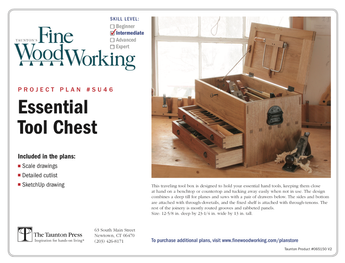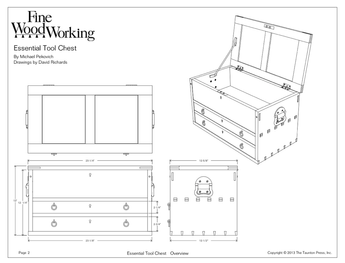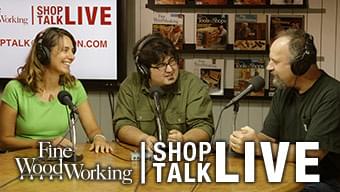I am making a Workbench out of 8/4 Hard Maple. I have read through the Workbench book and several articles on FWW including Lon Schleining’s Essential Workbench. My workbench is a variation on Schleining’s workbench.
In none of these articles did the author use biscuits to align the boards together for the top but have gone to great lengths to make cauls to keep the top flat and aligned while gluing.
My question is do the biscuits do not guarantee the alignment needed ? or do they swell and crack/warp the wood? Should they not be used? Could you use them without gluing the actual biscuits (so they only serve to align the top)?
Any guidance/experience would be much appreciated.
Thanks,
Sanjeev














Replies
Sanjeev
You must be new to this site. Pretty vociferous about biscuits -
They do not make for perfect alignment, and they limit how much machining you can do to the top.
Bill
I dont believe that I would use biscuits either. I think clamping cauls would be the way to go.
Mike
You could use biscuts just keep them far enough from the top so you can mill your top without the biscuts showing up. I did not use them when I made my top I milled my lumber square and flat then glued the top up into 11" inch wide sections then flattened them on a large jointer and surface planed them then glued them together to form a 30" wide top. It ended up just needing a little flatting with a #7 and it was good to go.
Good luck I am sure you will be fine.
Troy
I pretty much did what Troy mentioned, though I made my sections in 12' widths and ran them through my planer, then glued up three sections. I didn't use biscuits, cauls only and I touched up the 3 glued sections with a hand plane. My problem with biscuits on anything is I could never get good alignment, I sold my cutter and bought a Kreg pocket hole jig ;-) TinCup
Thank you for your answers. I will go with the cauls.
Sanjeev,
I normally use a Plano press to edge-clamp planks together when making a panel or table top. A Plano clamps the edges but also applies force to the faces, to keep the whole thing flat. Pieces or planks to be edge-glued in the Plano are first made straight, square and even in thickness using a planer-thicknesser (jointer and planer, in American-speak).
When I made my near 3" thick 2ft X 6ft hard maple top for the workbench I knew it would be too heavy to lift out of the Plano. (The Plano press is mounted on a wall and holds the glued-up workpiece vertically). I therefore glued up the laminated pieces for the work bench top "freehand" using large Record F-clamps and T-bar clamps.
The faces to be glued were so wide (and therefore stable) that I could clamp them with the glued-up top oriented vertically (long edges facing up/down) on saw horses. There are (from memory) 7 or 8 6ft long pieces laminated to make a 2 ft wide top.
It isn't easy keeping all those glue-slippery thick pieces flat as you tighten the 5 or 6 clamps along their 6 foot length. Therefore I used biscuits every 12 inches or so to ensure that when the clamps were tightened the laminates lined up to make a flat face (top).
I put the biscuits dead centre (ie around 1.5 inches from the top faces) so that when I came to plane the top flat there would be no chance of revealing a biscuit. Nor was there any chance that the biscuit would telegraph through to the surface.
It took 5 minutes to make the biscuit slots, including setting the jointer. I suspect it would take a great deal longer (and a lot more material) to make and use cauls.
Many posters in past Knots threads have complained that biscuit joiners are not accurate enough to ensure exact alignment. I always say that what is needed is (1) an accurate jointer, not a ticky-tacky one and (2) proper technique, which is very easy once you read how to do it. All my extensive biscuiting has resulted in very good alignment indeed. I use a Mafell and either Lamello or Tanselli biscuits.
Lataxe, a jolly biscuiteer.
Biscuits work fine for registration, assuming you know how to use it and have it aligned properly. I use them for all my laminated panels. I didn't use them for my top, but don't see why you couldn't. One thing to note is letting the panels dry thoroughly before sanding so you won't have dips where your biscuits are (although this shouldn't be a problem with a 2" top).
I glued up my worktop in 3x 12" sections so I send them through the planer later. I then carefully glued up the sections with large f clamps and a couple scraps to keep the joint flat. Minimal hand planing required.
Cheers,
Nathan
My bench:
http://www.workshopbuzz.com/forum/viewtopic.php?t=5874&highlight=&sid=4f48556e554733855edb6630eff0663a
Hi Nathan,
I live in Moncton, and noticed the materials costs (#2 Common Ash - $1.50/bd-ft) in your link. Would love to know where you got the Ash for the tabletop?
This forum post is now archived. Commenting has been disabled